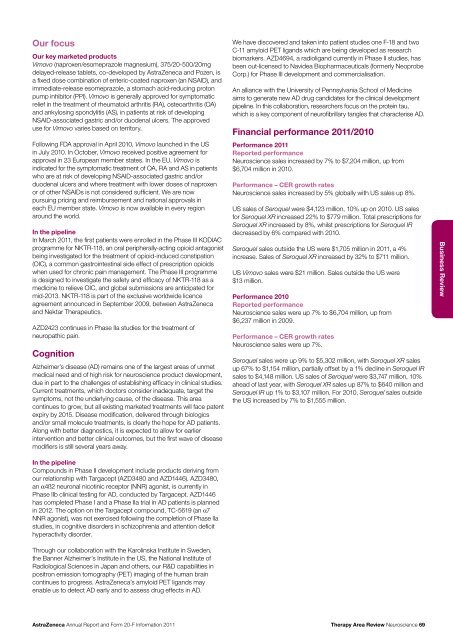AstraZeneca Annual Report and Form 20-F Information 2011
AstraZeneca Annual Report and Form 20-F Information 2011
AstraZeneca Annual Report and Form 20-F Information 2011
- No tags were found...
Create successful ePaper yourself
Turn your PDF publications into a flip-book with our unique Google optimized e-Paper software.
Our focusOur key marketed productsVimovo (naproxen/esomeprazole magnesium), 375/<strong>20</strong>-500/<strong>20</strong>mgdelayed-release tablets, co-developed by <strong>AstraZeneca</strong> <strong>and</strong> Pozen, isa fixed dose combination of enteric-coated naproxen (an NSAID), <strong>and</strong>immediate-release esomeprazole, a stomach acid-reducing protonpump inhibitor (PPI). Vimovo is generally approved for symptomaticrelief in the treatment of rheumatoid arthritis (RA), osteoarthritis (OA)<strong>and</strong> ankylosing spondylitis (AS), in patients at risk of developingNSAID-associated gastric <strong>and</strong>/or duodenal ulcers. The approveduse for Vimovo varies based on territory.Following FDA approval in April <strong>20</strong>10, Vimovo launched in the USin July <strong>20</strong>10. In October, Vimovo received positive agreement forapproval in 23 European member states. In the EU, Vimovo isindicated for the symptomatic treatment of OA, RA <strong>and</strong> AS in patientswho are at risk of developing NSAID-associated gastric <strong>and</strong>/orduodenal ulcers <strong>and</strong> where treatment with lower doses of naproxenor of other NSAIDs is not considered sufficient. We are nowpursuing pricing <strong>and</strong> reimbursement <strong>and</strong> national approvals ineach EU member state. Vimovo is now available in every regionaround the world.In the pipelineIn March <strong>20</strong>11, the first patients were enrolled in the Phase III KODIACprogramme for NKTR-118, an oral peripherally-acting opioid antagonistbeing investigated for the treatment of opioid-induced constipation(OIC), a common gastrointestinal side effect of prescription opioidswhen used for chronic pain management. The Phase III programmeis designed to investigate the safety <strong>and</strong> efficacy of NKTR-118 as amedicine to relieve OIC, <strong>and</strong> global submissions are anticipated formid-<strong>20</strong>13. NKTR-118 is part of the exclusive worldwide licenceagreement announced in September <strong>20</strong>09, between <strong>AstraZeneca</strong><strong>and</strong> Nektar Therapeutics.AZD2423 continues in Phase IIa studies for the treatment ofneuropathic pain.CognitionAlzheimer’s disease (AD) remains one of the largest areas of unmetmedical need <strong>and</strong> of high risk for neuroscience product development,due in part to the challenges of establishing efficacy in clinical studies.Current treatments, which doctors consider inadequate, target thesymptoms, not the underlying cause, of the disease. This areacontinues to grow, but all existing marketed treatments will face patentexpiry by <strong>20</strong>15. Disease modification, delivered through biologics<strong>and</strong>/or small molecule treatments, is clearly the hope for AD patients.Along with better diagnostics, it is expected to allow for earlierintervention <strong>and</strong> better clinical outcomes, but the first wave of diseasemodifiers is still several years away.In the pipelineCompounds in Phase II development include products deriving fromour relationship with Targacept (AZD3480 <strong>and</strong> AZD1446). AZD3480,an α4ß2 neuronal nicotinic receptor (NNR) agonist, is currently inPhase IIb clinical testing for AD, conducted by Targacept. AZD1446has completed Phase I <strong>and</strong> a Phase IIa trial in AD patients is plannedin <strong>20</strong>12. The option on the Targacept compound, TC-5619 (an α7NNR agonist), was not exercised following the completion of Phase IIastudies, in cognitive disorders in schizophrenia <strong>and</strong> attention deficithyperactivity disorder.Through our collaboration with the Karolinska Institute in Sweden,the Banner Alzheimer’s Institute in the US, the National Institute ofRadiological Sciences in Japan <strong>and</strong> others, our R&D capabilities inpositron emission tomography (PET) imaging of the human braincontinues to progress. <strong>AstraZeneca</strong>’s amyloid PET lig<strong>and</strong>s mayenable us to detect AD early <strong>and</strong> to assess drug effects in AD.We have discovered <strong>and</strong> taken into patient studies one F-18 <strong>and</strong> twoC-11 amyloid PET lig<strong>and</strong>s which are being developed as researchbiomarkers. AZD4694, a radiolig<strong>and</strong> currently in Phase II studies, hasbeen out-licensed to Navidea Biopharmaceuticals (formerly NeoprobeCorp.) for Phase III development <strong>and</strong> commercialisation.An alliance with the University of Pennsylvania School of Medicineaims to generate new AD drug c<strong>and</strong>idates for the clinical developmentpipeline. In this collaboration, researchers focus on the protein tau,which is a key component of neurofibrillary tangles that characterise AD.Financial performance <strong>20</strong>11/<strong>20</strong>10Performance <strong>20</strong>11<strong>Report</strong>ed performanceNeuroscience sales increased by 7% to $7,<strong>20</strong>4 million, up from$6,704 million in <strong>20</strong>10.Performance – CER growth ratesNeuroscience sales increased by 5% globally with US sales up 8%.US sales of Seroquel were $4,123 million, 10% up on <strong>20</strong>10. US salesfor Seroquel XR increased 22% to $779 million. Total prescriptions forSeroquel XR increased by 8%, whilst prescriptions for Seroquel IRdecreased by 6% compared with <strong>20</strong>10.Seroquel sales outside the US were $1,705 million in <strong>20</strong>11, a 4%increase. Sales of Seroquel XR increased by 32% to $711 million.US Vimovo sales were $21 million. Sales outside the US were$13 million.Performance <strong>20</strong>10<strong>Report</strong>ed performanceNeuroscience sales were up 7% to $6,704 million, up from$6,237 million in <strong>20</strong>09.Performance – CER growth ratesNeuroscience sales were up 7%.Seroquel sales were up 9% to $5,302 million, with Seroquel XR salesup 67% to $1,154 million, partially offset by a 1% decline in Seroquel IRsales to $4,148 million. US sales of Seroquel were $3,747 million, 10%ahead of last year, with Seroquel XR sales up 87% to $640 million <strong>and</strong>Seroquel IR up 1% to $3,107 million. For <strong>20</strong>10, Seroquel sales outsidethe US increased by 7% to $1,555 million.Business Review<strong>AstraZeneca</strong> <strong>Annual</strong> <strong>Report</strong> <strong>and</strong> <strong>Form</strong> <strong>20</strong>-F <strong>Information</strong> <strong>20</strong>11Therapy Area Review Neuroscience 69










